HPU Patterns
HPU Patterns
All Hook-Point-Up (HPU) patterns have three components. First, lead or brass eyes placed below the hook-eye. Second, some sort of tying material such as deer hair, feathers, fur, or hanked material tied in above the hook-eye. Third, a sturdy and often large streamer hook. The popular Clouser Minnow is an example of such a pattern. Its greatest attribute is to ride hook-point-up (h.p.u.) in all types of waters - but at what cost to the angler? When using large hooks, the amount of weight in the eyes creates problems. First it limits the size of rod can be used to cast the fly. Smaller weight rods like five weights and less perform poorly casting large weights, thus the angler is forced to use a heavier line-weight rod. Second, in shallow, debris, and/or weedy water - whether the water is moving or not - the heavy-eyed pattern often finds the bottom too quickly. If the angler does not retrieve the fly swiftly then it bumps along the bottom or becomes fouled in the greenery. Letting the fly glide slowly off of a log to the bottom or lazily swim over a weed bed is an impossibility. While the Clouser is a good pattern it offers the angler little versatility in the retrieve or fishing depth. Let’s take a look at the components of a Clouser and with a little reasoning, common sense, elementary physics, and simple hydrodynamics we can come up with a better functioning pattern that achieves unbelievable results. 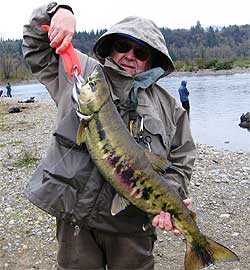 First, the large weighted eyes and their placement is a very critical component of a good Clouser style pattern. The reason for the eyes is to counteract the leverage of the hook-bend and hook-point. The hook-bend and hook-point are not extremely heavy, but, because they are far above or below the hook-eye (depending upon the hook’s position) they have considerable leverage that influence the pattern’s posture. Placing the eyes below the hook-eye or hook-shank overcomes this leverage. The eyes can be placed up near the hook-eye, as in a minnow pattern, or at the hook-bend, as in a crawfish pattern. No matter which end of the hook-shank they are on, the purpose is the same. First, the large weighted eyes and their placement is a very critical component of a good Clouser style pattern. The reason for the eyes is to counteract the leverage of the hook-bend and hook-point. The hook-bend and hook-point are not extremely heavy, but, because they are far above or below the hook-eye (depending upon the hook’s position) they have considerable leverage that influence the pattern’s posture. Placing the eyes below the hook-eye or hook-shank overcomes this leverage. The eyes can be placed up near the hook-eye, as in a minnow pattern, or at the hook-bend, as in a crawfish pattern. No matter which end of the hook-shank they are on, the purpose is the same. The second component of a HPU pattern is the tying material which can decrease the leverage of the hook-bend and hook-point and lessen the amount of weight needed in the eyes. If the tying materials are non-buoyant and tied in below the hook-eye then the weight of the materials help to counteract the hook-bend and lessen the amount of weight needed in the eyes. Thus, using buoyant materials above the hook-eye helps to float the pattern upright and also lessen the effect of the hook-bend. Buoyant materials below the hook-eye tend to increase the leverage of the hook-bend and increases the amount of lead needed for stability. However, I rarely if ever use buoyant material like deer hair for my HPU’s. I find that synthetic materials are tougher, have richer dyed colors, and come in a larger selection of both colors and textures. The third component of a good HPU pattern is the style of hook that is used. The use of light wire and small hook-gaps can also decrease the leverage of the hook-bend and the hook-point, but the overall hook style is the best component of a light-weight, large, hook-gaped pattern that rides h.p.u. The straight-eyed or flat-ring-eyed streamer hook is not an advantage to a good HPU pattern. Don’t get me wrong, I’m not saying that these are not good hooks. My point is that because the hook-eye is between the lead eyes and the hook-bend and point, there is no advantage in using this style hook. Turned-down-eyed or turned-up-eyed hooks are worse. The hook-eye is the guiding edge of the pattern. The hook-eye should be either perpendicular to the plane of the hook-bend (as in a straight-eyed hook) or in the same plane of the hook-bend (as in a flat ring-eyed hook). Turned-up and turned-down eyed hooks cause the pattern to spin in swift current or when jerked suddenly because of the oblique angle of the hook-eye. Spinning also occurs in other streamer patterns that are tied on turned-eyed hooks. I have often wondered why more tyers don’t chose straight or flat-ringed hooks instead when tying non-Clouser style streamers. Twisted or turned hooks (those where the hook-bend is not in alignment or same plane with the hook-shank) also cause a streamer to spin. If the hook is twisted or turned, straighten the twist before tying the pattern. In straight shank hooks, the hook-eye is at the top of the hook-bend. This is the main reason so much weight is needed to counteract the leverage of the hook-bend and hook-point. If the hook-eye was in the middle or slightly above the middle of the hook-bend then no weight is required to counteract the forces created by the hook-bend and hook-point. As you can see the style of eye and its placement in the hook configuration is the most important aspects of building a great h.p.u. fly. The best hook for a HPU would be a style that rides in the h.p.u. position before we tie anything on it and has a flat ring-eye or a straight-eye. Then the amount of lead or brass needed to stabilize the pattern would be minimal or possibly not needed at all. Which hook available to tiers fits this description? There are several hooks that ride in the h.p.u. position. Few however are used regularly by fly fisherman. Jig hooks are the first that comes to mind, but they will spin. Jig hooks aren’t very stable without some sort of weight. Several plastic worm hooks ride h.p.u., some are very stable without weight and some aren’t. For example, the new Gamakatsu G-Lock Worm hook is stable without any weight, but when large amounts of materials are added it will often wobble or run tilted. This is especially true of the smaller size #4. Larger hook sizes of this style don’t experience this problem. Lastly, the old fashion, Off-Set Worm hooks are very stable. Even a bare Offset Worm hooks will ride h.p.u. in the swiftest of water. Weighted eyes and materials don’t change this asset. Off-Set Worm hooks come in sizes from #2 to #5/o. It is too bad they don‘t come in smaller sizes of #4 and #6. Some are cheaply made and others are expensive, but you get what you pay for. Different brands and styles come with different attributes such as: light, medium, or heavy wire; stiff or not-so stiff wire; large barbs or micro barbs; cutter points, extremely sharp points or duller; closed or not-so closed hook-eyes. Whatever you desire, it is out there. In summary, the components of a great HPU pattern start with a hook that rides h.p.u. before adding materials. I suggest a style that has the hook-eye in the middle of the hook-bend like an Offset Worm hook or a G-lock Worm hook. Second, if you are going to use buoyant materials, use them only above the hook-eye. Third, because of the assets of using a h.p.u. style hook, eyes have become more of a decoration and less of a necessity. Smaller, lighter (not necessarily lead) eyes can be used to give the pattern unbelievable stability. I find that a 5/32 inch brass hour-glass eye is enough weight to create a very stable #2 HPU Brite-Eyed Shiner. Be intelligent about your streamer patterns. The lighter your streamer patterns the better it can behave like a baitfish. And the lighter streamer patterns make it easier for most species of fish to inhale your imitation. That’s called a bite and I design my flies to improve that result. HPU’s are not limited to streamers. The following are examples of patterns using the principles of a good HPU pattern and some examples of their productivity. Patterns using Off-Set Worm hooks allow the tier to be very creative. Such things as weight, beads, flashy materials , hanked materials can be added to the shank. A minnow pattern can have a gut sack in the space behind the eye, a short chin, and more. 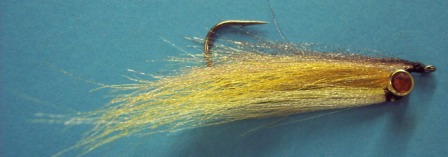 HPU Gut Sack Brite-Eyed Shiner#2 Gamakatsu Offset Worm Hook, 5/32” Real Eye, Spirit River Fluoro Fibre body, Holographic Mylar Motion silver flash and Poly Bear gut sack. 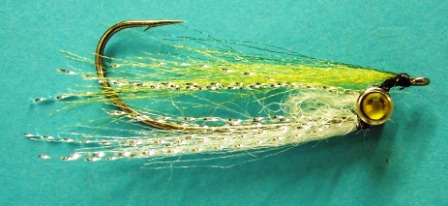 HPU Policeman Brite-Eyed Shiner#2 Gamakatsu Offset Worm Hook, 5/32” Real Eye, Spirit River Fluoro Fibre body and Holographic Mylar Motion silver flash Just because Offset Worm Hooks do not come in sizes smaller than #2 doesn’t mean that you can’t make your own. Some hooks can be bent to make very adequate small offset hooks. I prefer Eagle Claw 214 Aberdeen bronze hooks because they come in the hook-shank proportions that make very good #4 and #6 offset hooks. With a small pair of needle-nose pliers bend the eye portion of the offset then the drop or down section. Surprisingly, the self-made offset worm hook in these sizes are stouter than the original Aberdeen and the bend of the hook is less apt to the straighten under pressure. The bent hook reduces the leverage of the long hook shank and the repositioned hook-eye centers the fish’s weight in the hook-bend. HPU patterns tied on these smaller hooks can be cast with a one weight rod and are great for trout, sunfish, and the basses. 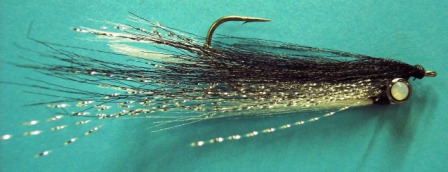 #4 HPU Dazl-Eyed Shiner in Spirit River Fluoro Fibre Neon pink and purple. 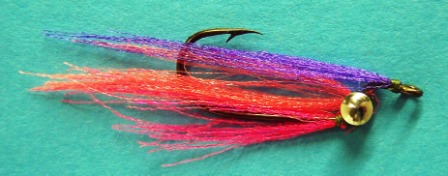 #4 HPU Dazl-Eyed Shiner in Spirit River Fluoro Fibre dark green and electric yellow body with Gliss'n Glow gold flash. Crawfish style patterns are extremely stable, light, and effective. HPU Crawfish can either have their eyes at the beginning of the hook-bend, at the bottom of the off-set, or just wrap lead around the hook-shank. Of these three choices, placing the eyes at the beginning of the hook-bend like the example below is the best performer all around. Lead wrapped around the hook-shank is best used in fast water when the pattern will not rest on the bottom (there are no eyes in this choice to hold the crawfish upright when resting on the bottom). The eyes tied in the off-set of the hook-shank of any style pattern is the most durable eye placement. In the limestone streams and rivers of the Ozarks this is most evident. 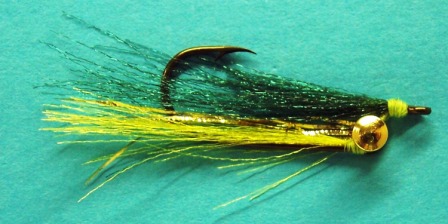 HPU Mudbug #2 Gamakatsu Offset Worm hook, Swiss Straw back, Pheasant feather pinchers, Spirit River I-Balz eyes, Tarantula rubber legs and antennae, and sparkle yarn body 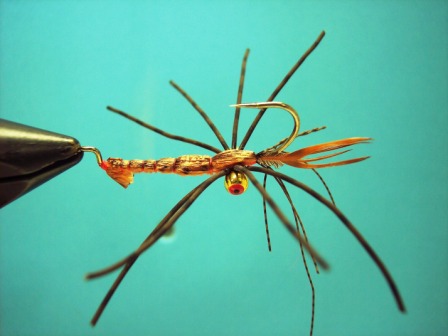 HPU Willow Worms made with rabbit, pine squirrel, and/or mink can also be very different. Willow Worms with more than one tail, with a tail and a wing, with a body and a disjointed tail, and several more possibilities exist. 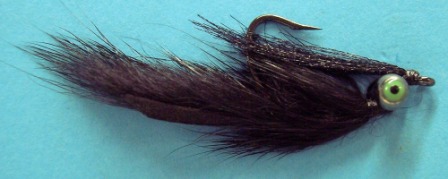 HPU Willow Worm #2 Gamakatsu G-Lock Worm hook, Spirit River I-Balz eyes, Fluoro Fibre wing, Wapsi Pine Squirrel body. 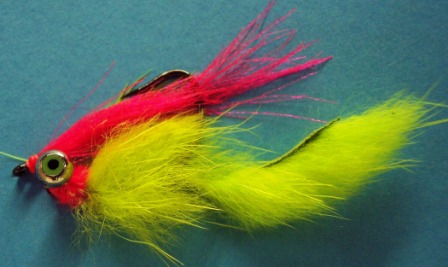 HPU Willow Worm #2 Gamakatsu G-Lock Worm hook, Spirit River I-Balz eyes, Fluoro Fibre wing, Sparkle Chenille gills, Wapsi Micro Mink body. 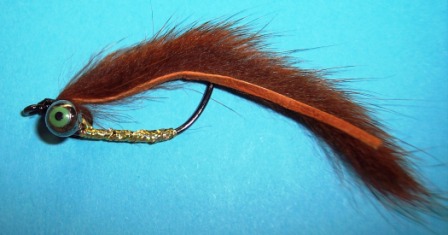 HPU Willow Worm #2 Gamakatsu G-Lock Worm hook, Spirit River I-Balz eyes, Bodi Braid body, Wapsi Pine Squirrel tail. Floating HPU’s made with floating eyes and/or foam strips are just as weedless and snag-free as sinking HPU’s. Floating eyes can be made from round-ball Styrofoam indicators and a toothpick, tied in above or below the hook-eye. Foam strips can be applied most anywhere. Try this - Floating eyes, a foam strip around the hook-shank with rubber legs, and a foam wing on top makes an easy, effective, weedless grasshopper pattern. 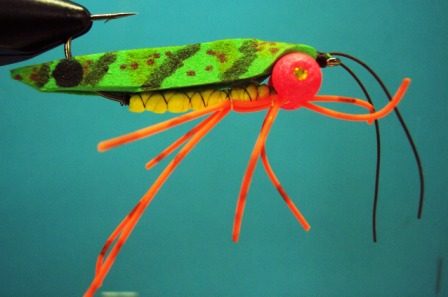 HPU Floating Grasshopper 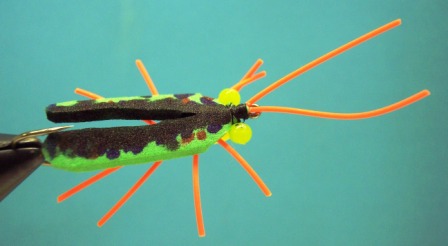 HPU Floating Beetle  HPU Floating Willow Snake 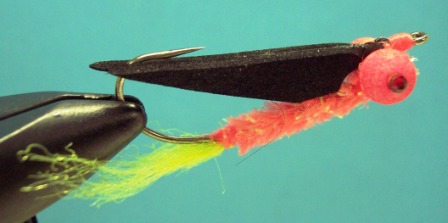 HPU Floating Topminnow On a recent trip to British Columbia, my HPU Brite-Eyed Shiners and Willow Worms prove to be the flies of choice. Because of their h.p.u. posture, in the swiftest of waters, very few fish were snagged in their dorsal which is a common occurrence in salmon fishing. Snagged fish are like hooking a rock and don’t fight well. Mouth-hooked salmon are like hooking a rocket and fighting a bulldog, at the same time. Even the local fisherman, who weren’t fly fishing, were impressed with how few salmon I snagged using these patterns. Because British Columbia fishing laws allow that only mouth-hooked salmon can be taken for consumption, effective patterns such as these were of great interest. HPU’s are great patterns for generating more bites and less hang-ups. This means less “Not Fishing Time” and more “Quality Fishing Time“. Their lightness and stability increase their versatility which aids the angler in making better natural presentations. Remember that any type of fishing is simple statistics at work. The more time the fly is fished naturally in the strike zone, the more opportunity there is to get a bite. More bites increase the chances of catching more and bigger fish - so fish for the bite. Gone Fishin’
Fox Statler
|